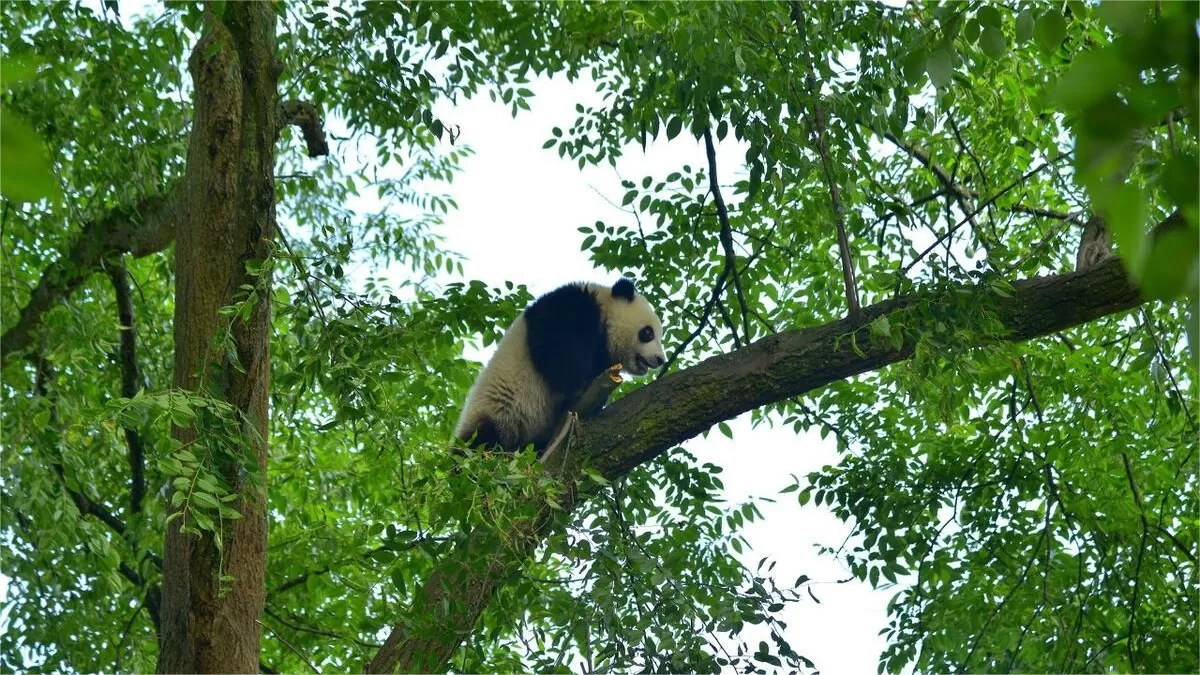Pandas are generally not aggressive animals and rarely attack humans. Their diet consists mainly of bamboo, and they spend most of their time eating, resting, or occasionally socializing with other pandas. As a rule, pandas are solitary and shy creatures that tend to avoid human contact in the wild. However, there are recorded incidents where pandas, both in captivity and in the wild, have attacked humans, mostly under unusual or stressful circumstances.
1. Incidents in Captivity
In captivity, pandas are accustomed to human caregivers and generally display a calm demeanor. However, even in zoos, pandas are wild animals at heart, and sudden or unpredictable movements, loud noises, or unfamiliar individuals can cause them stress. This is why direct interaction with pandas is limited, even for trained staff, as there’s always a slight risk of defensive reactions.
1.1 Chengdu Giant Panda Base Incident
- Date: November 2, 2000
- Location: Chengdu Giant Panda Base, China
- Summary: A 14-year-old student entered a restricted panda activity area during a school-organized visit. Upon entering, he was attacked by a panda and sustained minor injuries.
- Outcome: The student’s family sued both the Chengdu Panda Base and the school. However, the court ruled that the base was not at fault and held the student and school accountable. Despite this, the panda base chose not to ask for a reimbursement of over 10,000 yuan in medical expenses, considering it a goodwill gesture.
1.2 Beijing Zoo – Panda “Gu Gu” Incidents
- Dates: 2006, 2007, 2009, and 2012
- Location: Beijing Zoo, China
- Summary: Over four years, a male panda named Gu Gu bit four visitors who entered his enclosure illegally. Two individuals sustained serious injuries, and two suffered minor wounds. In one incident, an intoxicated man climbed over a two-meter fence and approached the sleeping panda. Startled, Gu Gu reacted defensively and bit the man.
- Outcome: In response to these incidents, Beijing Zoo increased safety measures and reinforced guidelines to remind visitors to respect boundaries and adhere to safety protocols.
1.3 Panda “Xi Mei” Attacks Keeper
- Date: December 2016
- Location: A panda rewilding center in China
- Summary: At a rewilding site, a female panda named Xi Mei attacked her keeper, Wei Hua, during a routine check. Wei inadvertently came between Xi Mei and her cub, “Ba Xi,” triggering Xi Mei’s maternal instincts. The attack lasted five minutes, resulting in serious injuries: severed tendons in Wei’s foot, extensive muscle damage in all four limbs, and partial loss of his left hand.
- Outcome: Wei received emergency medical treatment and survived, though with severe physical trauma. This incident highlights the protective nature of mother pandas toward their cubs.
1.4 Nanchang Zoo Incident
- Date: October 27, 2016
- Location: Nanchang Zoo, China
- Summary: A young man climbed into the panda enclosure and began provoking a resting panda. The panda pinned the intruder down, but the man eventually managed to escape without injury.
- Outcome: Following this incident, the zoo took steps to improve safety management and educate visitors about respecting animal boundaries.
1.5 San Diego Zoo – Panda “Bai Yun” Incident
- Date: March 13, 2011
- Location: San Diego Zoo, USA
- Summary: The panda, Bai Yun, attacked a zookeeper during an attempt to guide her back into her enclosure. The zookeeper sustained serious injuries. The exact reason for Bai Yun’s aggression remains unclear, though it is thought that an inadvertent miscommunication may have triggered her reaction.
- Outcome: The zookeeper received immediate medical care, and the zoo conducted a thorough investigation to reinforce safety measures.
2. Incidents in the Wild
Giant pandas have a docile and gentle nature compared to many other wild animals. Their primary focus in the wild is eating bamboo (How Much Bamboo does a Panda Eat?), resting, and occasionally interacting with other pandas during the mating season. Generally, pandas prefer to avoid encounters with humans and will retreat if they sense human presence nearby. However, defensive reactions may occur if they feel threatened or perceive a human’s actions as hostile.
2.1 Dujiangyan Villager Incident
- Date: March 2012
- Location: Dujiangyan, China
- Summary: While walking, a group of villagers spotted a wild panda and began following it. One villager attempted to approach the panda, prompting the animal to bite him. Fortunately, the injuries were not severe.
- Analysis: This defensive bite likely resulted from the panda feeling threatened by the close human presence. Pandas may react defensively when faced with a perceived threat, even from harmless behavior such as close observation.
2.2 Liziba Village Incident, Gansu Province
- Date: March 2014
- Location: Liziba Village, Wen County, Gansu Province, China
- Summary: A 68-year-old villager encountered a wild panda while harvesting tea. Mistaking the villager’s presence as a threat, the panda attacked, biting his lower right leg and ankle. This led to severe injuries, including the severing of major arteries and fractures.
- Analysis: The panda likely felt frightened or cornered by the sudden presence of the villager. The high level of fear and perceived confinement could have triggered its instinct to defend itself.
Conclusions and Safety Recommendations
While pandas are not naturally aggressive, these incidents underscore the importance of respecting their space and observing strict boundaries, especially in areas where human and panda encounters might overlap. Whether in captivity or the wild, pandas can react defensively if they feel threatened or startled.
Key Safety Takeaways:
- Avoid Approaching Pandas in the Wild: If you spot a panda in its natural habitat, maintain a respectful distance. Attempting to interact with a wild panda can cause distress or provoke a defensive reaction.
- Follow Rules and Boundaries in Zoos and Sanctuaries: Many incidents occurred when individuals ignored warnings and entered restricted areas. For their safety and that of the pandas, visitors should respect all guidelines.
- Consider Panda Behavior When Interacting with Cubs: Mother pandas are highly protective of their cubs. Caregivers and researchers in conservation areas should exercise caution and avoid positioning themselves between a mother and her cub.
- Limit Direct Human-Panda Interactions: In captive settings, pandas may grow accustomed to human presence, but direct interaction should still be minimized to prevent accidental injuries.




